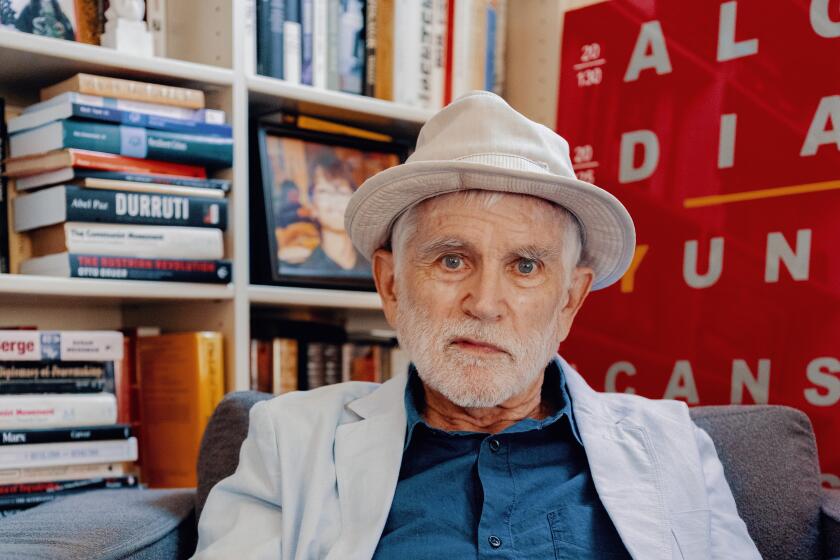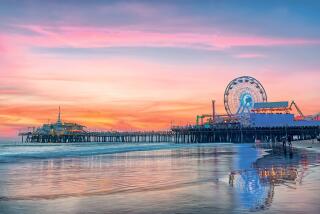The 3 essential Mike Davis books that explain L.A.

It’s impossible to overstate the significance of Mike Davis, who died Tuesday at 76 from complications related to esophageal cancer. For almost all of us who write and think about Los Angeles, he was not only a touchstone but also a lodestar, the most important and original thinker about the city since Carey McWilliams defected to New York in 1951.
Davis would write 20 books, including “Late Victorian Holocausts: El Niño Famines and the Making of the Third World” and “Planet of Slums: Urban Involution and the Informal Working Class.” But to me, his legacy is built on what I’ve come to imagine as his Los Angeles trilogy: “City of Quartz: Excavating the Future in Los Angeles” (Verso, 512 pp., $21.95 paper), “Ecology of Fear: Los Angeles and the Imagination of Disaster” (Verso, 496 pp., $24.95 paper) and “Set the Night on Fire: L.A. in the Sixties” (Verso, 800 pp., $24.95 paper). The first of these volumes changed everything when it came out in late 1990, six months before the beating of Black motorist Rodney King by four white LAPD officers laid the hypocrisies of the city bare. If you’re looking for a way into reading and thinking about Davis, you could do a lot worse than to start with these three works.
‘City of Quartz’
This wasn’t Davis’ first book but his second, although in every way that matters, it is where his career begins. That’s because the arguments he is making are so interwoven, it is as if he is revealing the city to us anew. By that, I don’t mean his writing here was sui generis; its antecedents include McWilliams’ “Southern California Country: An Island on the Land” (1946) and Louis Adamic’s “Laughing in the Jungle” (1932). But if Davis was, in many ways, their inheritor, he was also staking out a territory of his own. “City of Quartz” is steeped in history; it begins with a visit to the lost colony of Llano, the short-lived Utopian settlement built in the Antelope Valley in 1914. At the same time, it seeks to use that history both to describe the city of the moment and to project what that city might become. In its pages, Davis takes on the abiding narratives of the place — the Booster myth, the Mission myth, the framing of Southern California as somehow Edenic — to explore a more complex set of realities. Central to his argument is the notion of Los Angeles as a contradictory landscape, one marked by both sunshine and noir. This he described as a “master dialectic,” in which the prevailing legends are circumscribed, or undermined, by the experience of living in the city, in which economic and other disparities create inequities that are impossible to reconcile.
‘Ecology of Fear’
Published in 1998 — the same year Davis won a MacArthur — this is the follow-up to “City of Quartz,” a book that examines the relationship of disaster, real and imagined, to the way the city sees itself. In part, this has to do with real estate; in a chapter called “How Eden Lost Its Garden,” Davis deconstructs the ways in which “hazard zoning” (which limits development on floodplains and in proximity to seismic faults) has been undermined or disregarded, leading to what he calls “disaster inflation.” As always with Davis, the trouble is not only avarice but also denial, an issue he brings to the fore when he contrasts federal disaster aid for homes in Malibu destroyed by wildfire with the neglect of urban neighborhoods where there is most often no relief, federal or otherwise, when old apartment buildings burn. Davis was criticized in the wake of the book’s publication for playing fast and loose with some of the facts, but the argument he was making is a cogent one, and never more than in his discussion of the way disaster and the city are treated in more than 100 films and novels, which portray apocalypse as inevitable, even romantic, rather than a devastation of people’s lives.
‘Set the Night on Fire’
Co-written with UC Irvine emeritus professor Jon Wiener, this massive inquiry, published in 2020, marked Davis’ return to Los Angeles as a subject, albeit through a different filter. Like his earlier books, “Set the Night on Fire” approached the city through something of a contrarian’s lens, puncturing old beliefs and shibboleths, particularly about the nature of 1960s activism on the West Coast. In part, this was geographic: Southern rather than Northern California as the seat of social change. In part, it was racial, the notion that the city’s liberation movements were largely brown and Black. Through it all, Davis and Wiener explored the notion of Los Angeles as a center of social justice efforts, including the Chicano Moratorium and the gay rights movement, which arguably grew out of the Mattachine Society, founded in 1950 in Southern California by activist Harry Hay. As Davis’ final book, “Set the Night on Fire” is a fitting coda to an essential career.
Ulin is a former books editor and books critic for The Times.
With ‘City of Quartz’ and other influential works, Mike Davis shaped generations of thinking about Los Angeles and its origins.
More to Read
Sign up for our Book Club newsletter
Get the latest news, events and more from the Los Angeles Times Book Club, and help us get L.A. reading and talking.
You may occasionally receive promotional content from the Los Angeles Times.







